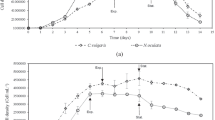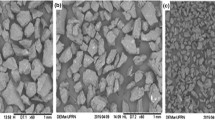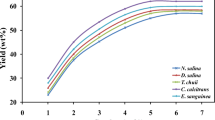Abstract
Microalgae have the potential to synthesize and accumulate lipids which contain high value fatty acids intended for nutrition and biodiesel applications. Nevertheless, lipid extraction methods for microalgae cells are not well established and there is not a standard analytical methodology to extract fatty acids from lipid-producing microalgae. In this paper, current lipid extraction procedures employing organic solvents (chloroform/methanol, 2:1 and 1:2, v/v), sodium hypochlorite solution (NaClO), acid-catalysed hot-water extraction and the saponification process [2.5 M KOH/methanol (1:4, v/v)] have been evaluated with two species of microalgae with different types of cell walls. One is a marine diatom, Phaeodactylum tricornutum, and the other a freshwater green microalga, Haematococcus pluvialis. Lipids from all types of extracts were estimated gravimetrically and their fatty acids were quantified by a HPLC equipped with Q-TOF mass spectrometer. Results indicated significant differences both in lipids yield and fatty acids composition. The chloroform and methanol mixture was the most effective extraction solvent for the unsaturated fatty acids such as DPA (C22:05), DHA, (C22:06), EPA (C20:05) and ARA (C20:04). While acid treatments improved the saturated fatty acids (SFAs) yield, especially the short chain SFA, lauric acid (C12:0), whose amount was 64% higher in P. tricornutum and 156% higher in H. pluvialis compared to organic solvent extractions.

ᅟ



Similar content being viewed by others
References
Sanghvi AM, Lo YM. Present and potential industrial applications of macro- and microalgae. Recent Pat Food Nutr Agric. 2010;2(3):187–94.
Choi S-A, Jung J-Y, Kim K, Lee J-S, Kwon J-H, Kim S, et al. Acid-catalyzed hot-water extraction of docosahexaenoic acid (DHA)-rich lipids from Aurantiochytrium sp. KRS101. Bioresour Technol. 2014;161:469–72.
Lei A, Chen H, Shen G, Hu Z, Chen L, Wang J. Expression of fatty acid synthesis genes and fatty acid accumulation in Haematococcus pluvialis under different stressors. Biotechnol Biofuels. 2012;5(1):18. doi:10.1186/1754-6834-5-18.
Cavonius LR, Carlsson NG, Undeland I (2014) Quantification of total fatty acids in microalgae: comparison of extraction and transesterification methods. Anal Bioanal Chem 406 (28): 7313-22.
Folch J, Lees M, Sloane-Stanley G. A simple method for the isolation and purification of total lipids from animal tissues. J Biol Chem. 1957;226:497–509.
Adarme-Vega TC, Lim DK, Timmins M, Vernen F, Li Y, Schenk PM. Microalgal biofactories: a promising approach towards sustainable omega-3 fatty acid production. Microb Cell Factories. 2012;11:96. doi:10.1186/1475-2859-11-96.
Saha SK, McHugh E, Hayes J, Moane S, Walsh D, Murray P. Effect of various stress-regulatory factors on biomass and lipid production in microalga Haematococcus pluvialis. Bioresour Technol. 2013;128:118–24.
Bligh E, Dyer W. A rapid method of total lipid extraction and purification. Can J Biochem Physiol. 1959;37:911–7.
Yongmanitchai W, Ward OP. Growth of and omega-3 fatty acid production by Phaeodactylum tricornutum under different culture conditions. Appl Environ Microbiol. 1991;57(2):419–25.
Cho SC, Choi WY, Oh SH, Lee CG, Seo YC, Kim JS, Song CH, Kim GV, Lee SY, Kang DH, Lee, HY (2012) Enhancement of lipid extraction from marine microalga, Scenedesmus associated with high-pressure homogenization process. J Biomed Biotechnol(6 pageshttp://dx.doi.org/10.1155/2012/359432): p. 359432.
Lohman EJ, Gardner RD, Halverson L, Macur RE, Peyton BM, Gerlach R. An efficient and scalable extraction and quantification method for algal derived biofuel. J Microbiol Methods. 2013;94(3):235–44.
Li Y, Ghasemi Naghdi F, Garg S, Adarme-Vega TC, Thurecht KJ, Ghafor WA, et al. A comparative study: the impact of different lipid extraction methods on current microalgal lipid research. Microb Cell Factories. 2014;13:14. doi:10.1186/1475-2859-13-14.
Liu K-S. Preparation of fatty acid methyl esters for gas-chromatographic analysis of lipids in biological materials. JAOCS. 1994;71(11):1179–80.
Park J-Y, Choi S-A, Jeong M-J, Nam B, Oh Y-K, Lee J-S. Changes in fatty acid composition of Chlorella vulgaris by hypochlorous acid. Bioresour Thechnol. 2014;162:379–83.
Park JY, Oh YK, Lee JS, Lee K, Jeong MJ, Choi SA. Acid-catalyzed hot-water extraction of lipids from Chlorella vulgaris. Bioresour Technol. 2014;153:408–12.
Norris PC, Dennis EA. Omega-3 fatty acids cause dramatic changes in TLR4 and purinergic eicosanoid signaling. Proc Natl Acad Sci U S A. 2012;109(22):8517–22.
Zhang R-Z, Li L, Liu S-T, Chem R-M, Rao P-F. An improved method of cholesterol determination in egg yolk by HPLC. J Food Biochem. 1999;23:351–61.
Ma YH, Wang X, Niu YF, Yang ZK, Zhang MH, Wang ZM, et al. Antisense knockdown of pyruvate dehydrogenase kinase promotes the neutral lipid accumulation in the diatom Phaeodactylum tricornutum. Microb Cell Factories. 2014;13(1):100. doi:10.1186/s12934-014-0100-9.
Saha SK, Hayes J, Moane S, Murray P. Tagging of biomolecules with deuterated water (D2O) in commercially important microalgae. Biotechnol Lett. 2013;35(7):1067–72.
He L, Han X, Yu Z. A rare Phaeodactylum tricornutum cruciform morphotype: culture conditions, transformation and unique fatty acid characteristics. PLoS One. 2014;9(4):e93922. doi:10.1371/journal.pone.0093922.
Hagen C, Siegmund S, Braune W. Ultrastructural and chemical changes in the cell wall of Haematococcus pluvialis (Volvocales, Chlorophyta) during aplanospore formation. Eur J Phycol. 2002;37(2):217–26.
Rippka R, Deruelles J, Waterbury J, Herdman M, Stanie RY. Generic assignments, strain histories and properties of pure cultures of cyanobacteria. J Gen Microbiol. 1979;111:1–61.
Dillon JT, Aponte JC, Tarozo R, Huang Y. Purification of omega-3 polyunsaturated fatty acids from fish oil using silver-thiolate chromatographic material and high performance liquid chromatography. J Chromatogr A. 2013;1312:18–25.
Woo SG, Yoo K, Lee J, Bang S, Lee M, On K, et al. Comparison of fatty acid analysis methods for assessing biorefinery applicability of wastewater cultivated microalgae. Talanta. 2012;97:103–10.
Wen ZY, Chen F. Heterotrophic production of eicosapentaenoic acid by microalgae. Biotechnol Adv. 2003;21(4):273–5.
Pribyl P, Cepak V, Zachleder V. Production of lipids in 10 strains of Chlorella and Parachlorella, and enhanced lipid productivity in Chlorella vulgaris. Appl Microbiol Biotechnol. 2012;94(2):549–61.
Ryckebosch E, Muylaert K, Foubert I. Optimization of an analytical procedure for extraction of lipids from microalgae. J Am Oil Chem Soc. 2011;89:189–98.
Cuellar-Bermudez SP, Aguilar-Hernandez I, Cardenas-Chavez DL, Ornelas-Soto N, Romero-Ogawa MA, Parra-Saldivar R. Extraction and purification of high-value metabolites from microalgae: essential lipids, astaxanthin and phycobiliproteins. Microb Biotechnol. 2015;8(2):190–209.
Choi SA, Jung JY, Kim K, Kwon JH, Lee JS, Kim SW, et al. Effects of molten-salt/ionic-liquid mixture on extraction of docosahexaenoic acid (DHA)-rich lipids from Aurantiochytrium sp. KRS101. Bioprocess Biosyst Eng. 2014;37(11):2199–204.
Acknowledgements
This work was supported by the Irish Research Council (Grant No. GOIPD/2015/681) and an Enterprise Ireland Innovation partnership grant (Grant No. IP/2013/0439). Paz Otero is recipient of a Government of Ireland Postdoctoral Award 2015 (GOIPD/2015/681).
Author information
Authors and Affiliations
Corresponding author
Ethics declarations
Conflict of interest
The authors have declared that they have no conflict of interest.
Rights and permissions
About this article
Cite this article
Otero, P., Saha, S.K., Gushin, J.M. et al. Identification of optimum fatty acid extraction methods for two different microalgae Phaeodactylum tricornutum and Haematococcus pluvialis for food and biodiesel applications. Anal Bioanal Chem 409, 4659–4667 (2017). https://doi.org/10.1007/s00216-017-0412-9
Received:
Revised:
Accepted:
Published:
Issue Date:
DOI: https://doi.org/10.1007/s00216-017-0412-9




